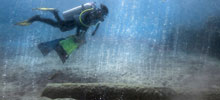Originally published March 30, 2014 at 9:24 PM | Page modified March 31, 2014 at 12:13 AM
Death toll reaches 21 as slide searchers ‘look for that miracle’
The death toll from the Snohomish County mudslide climbed by three to 21 on Sunday, and searchers found four additional victims who are not part of that official count. The number of people still missing after nine days of searching stands at 30.
Seattle Times staff reporter
![]()
The death toll from the Snohomish County mudslide climbed by three to 21 on Sunday, and searchers found four additional victims who are not part of that official count.
The number of people still missing after nine days of searching stands at 30, with state officials vowing to keep looking for survivors in what Gov. Jay Inslee, visiting the site, called a “mission ... to look for that miracle.”
The grim job found searchers on their hands and knees and up to their waists in muck, picking through piles of debris alongside family members of the missing who refused to give up hope.
Relatively sunny and dry weather Sunday helped clear out some of the pools of water that were complicating the search, said Jason Biermann, program manager for Snohomish County’s emergency management department.
The day started with two new additions to the site: a road, completed Saturday, that allowed searchers and their machinery to cross from east to west over the slide area, and a tent used to decontaminate workers as well as any mementos found in the rubble.
Lt. Richard Burke of the Bellevue Fire Department said during a media tour that probable contaminants at the site — household chemicals, petroleum, propane and human waste from septic systems — had to be washed off to prevent illness.
“We’re worried about dysentery, we’re worried about tetanus, we’re worried about contamination,” Burke said. “The last thing we want to do is take any of these contaminants out of here and take them into town, take them back to our families.”
Kris Rietmann, a spokeswoman with the Washington State Department of Transportation, said at a morning news conference in Darrington that volunteers were working as “memorabilia collection crews,” following behind searchers to collect personal belongings such as family photos. The belongings then will be decontaminated and securely stored “so families can be reunited with some of their belongings,” Rietmann said.
Some of the earliest visitors to the decontamination tent were search dogs, who had been taken off the job for two days of rest. One dog, a blonde lab named Nexus, fidgeted as the mud was sprayed from his legs, belly and neck with a hose.
Later in the day, Inslee toured the site by helicopter, spoke with agencies leading the search effort and visited with victims’ families.
At a news conference after the helicopter tour, Inslee said he is still referring to the search as a “recovery and rescue” operation because some of the people searching for their loved ones are holding out hope they’re still alive.
“We’ve provided them with every opportunity to find that miracle,” he said.
“The mission statement right now is to look for that miracle, rescue any possible survivors and also find loved ones to give them confidence. I’ve been talking to family members today and they are eager, as you can imagine, to know the fate of their loved ones. And we have a small army trying to give them that confidence and that knowledge to the extent humanly possible.”
Inslee said 400 to 500 people were laboring at the slide site Sunday. That figure included 117 members of the Air Force and Army national guards from Washington, according to guard commander Major Gen. Bret Daugherty.
A 14-person recovery team also arrived from Colorado to provide some relief to teams.
Inslee said searchers have only been able to access the periphery of the slide.
“Now, in a sense that works out well because most of the debris and the victims ended up in the periphery of the slide because of the huge violence and force of the slide.”
State officials are moving into “midterm and longer-term planning” mode, Inslee said, including finding housing for those who lost homes in the slide and looking ahead to a replacement for the stretch of state Highway 530 buried in mud.
He said the state has no specific plans for how or where to “re-establish” the damaged section of the highway, but he promised to be sensitive to the people who have lost loved ones.
Inslee was asked whether he has requested a review of apparently unauthorized logging in the area near the slide. He declined to address the issue, saying only:
“I don’t want to include or exclude anything. We will do a full-scale review of all circumstances related to this to see how it pertains to other areas as well.
“I know there are going to be a lot of questions about geology, about the river, about the massive precipitation we’ve had,” Inslee said. “A lot of those questions are legitimate questions that are going to take time to answer, and right now we’re focused on rescue and recovery, so we don’t have any of those answers today.”
Given the slow rate of recovery so far, officials Sunday reiterated warnings that the efforts under way near Oso will carry on for a good long time.
Some parts of the slide area, buried under as much as 80 feet of mud, trees and other debris, are still too dangerous to search, said Burke, the Bellevue fire lieutenant.
“I don’t know when we’re going to be done,” he said. “It’s going to take years to clean this all up and put families back together, put this community back together.”
Susan Kelleher: 206-464-2508 or skelleher@seattletimes.com
Times staff reporters Janet Tu and Hal Bernton and The Associated Press contributed to this report.
 Four weeks for 99 cents of unlimited digital access to The Seattle Times. Try it now!
Four weeks for 99 cents of unlimited digital access to The Seattle Times. Try it now!












